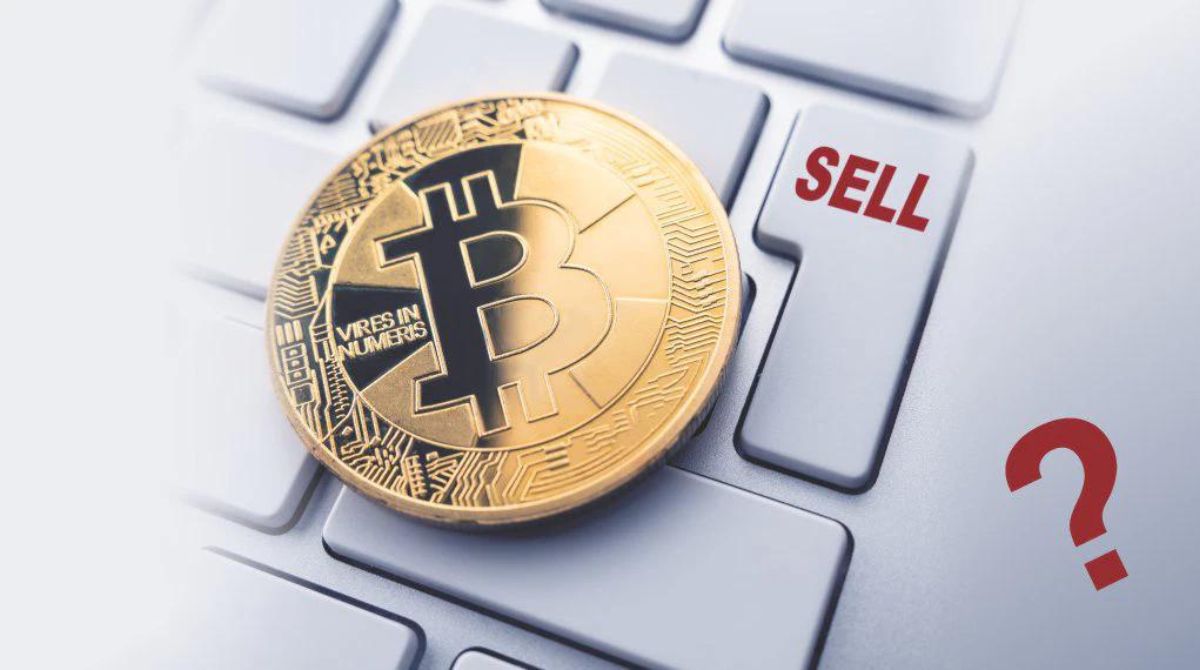Introduction
Bitcoin, the world’s first decentralized cryptocurrency, has gained significant popularity and value over the years. As more people and businesses embrace Bitcoin, there is an increasing need for a seamless process to sell this digital asset. Whether you want to cash out your Bitcoin investments or convert them into traditional currencies, selling Bitcoin can be a straightforward process.
In this article, we will guide you through the essential steps to sell Bitcoin effectively. From setting up a Bitcoin wallet to selecting the right exchange platform, verifying your account, and ensuring the security of your funds, we will cover everything you need to know.
Selling Bitcoin can be done through various methods, including peer-to-peer marketplaces and cryptocurrency exchanges. The method you choose depends on factors such as convenience, security, and the liquidity you are seeking. However, regardless of the method you opt for, remember that it is crucial to research and understand the process to make informed decisions and maximize your profits.
Before diving into the intricacies of selling Bitcoin, it is essential to note that the cryptocurrency market is highly volatile, and prices can change rapidly. Therefore, timing your sale strategically can help you secure the best possible value for your Bitcoin assets.
As you navigate the process of selling Bitcoin, keep in mind that certain legal and financial considerations may arise, such as tax obligations and reporting requirements. Understanding these aspects beforehand can help you navigate potential legal complexities and ensure compliance with relevant regulations.
Now that we have provided a brief overview, let’s delve into the step-by-step process of selling Bitcoin. From setting up a Bitcoin wallet to choosing the right exchange platform, verifying your account, and navigating the intricacies of taxation and security, we will equip you with the knowledge and tools to successfully sell your Bitcoin holdings.
Setting up a Bitcoin Wallet
Before you can sell Bitcoin, you need to have a secure and reliable Bitcoin wallet to store your digital assets. A Bitcoin wallet is a digital wallet that allows you to store, send, and receive Bitcoin.
There are various types of Bitcoin wallets available, each with its own advantages and security features. The three main types are:
- Hardware Wallets: These are physical devices specifically designed to securely store Bitcoin offline. Hardware wallets offer a high level of security as they keep your private keys offline, protecting them from potential cyber threats. Examples of popular hardware wallets include Ledger and Trezor.
- Software Wallets: These are software applications that you can install on your desktop or mobile devices. Software wallets offer convenience and accessibility but can be more vulnerable to security risks compared to hardware wallets. Some well-known software wallets include Electrum, Exodus, and Mycelium.
- Online Wallets: These are web-based wallets provided by cryptocurrency exchanges or third-party service providers. Online wallets are convenient, as they allow you to access your Bitcoin from any device with an internet connection. However, they can be more susceptible to hacking or online attacks. Examples of popular online wallets include Coinbase, BitPay, and Blockchain.com.
When choosing a Bitcoin wallet, ensure that it supports the features and security measures that align with your needs. Look for wallets that offer two-factor authentication, multi-signature functionality, and backup options to secure your funds.
Once you have selected a wallet, follow the provider’s instructions to set it up. This typically involves creating a unique username and password, and in some cases, generating a recovery phrase or PIN code to restore your wallet in case of loss or theft. It’s crucial to keep this information secure and not share it with anyone.
Remember that your Bitcoin wallet address is your unique identifier in the Bitcoin network. It’s a long alphanumeric string that you will use to receive Bitcoin. You can share this address with others to receive payments or when selling Bitcoin on exchanges or peer-to-peer platforms.
With your Bitcoin wallet set up and ready to go, you’re now prepared to move on to the next step: choosing a Bitcoin exchange.
Choosing a Bitcoin Exchange
When it comes to selling Bitcoin, choosing the right exchange is crucial. A Bitcoin exchange is a digital platform where you can buy, sell, and trade cryptocurrencies. It acts as an intermediary between buyers and sellers, facilitating the exchange of Bitcoin for other digital assets or traditional currencies.
There are several factors to consider when selecting a Bitcoin exchange:
- Security: Look for exchanges that prioritize stringent security measures, such as two-factor authentication, cold storage for funds, and insurance against theft or hacking. Additionally, check if the exchange has a good track record and positive user reviews regarding security practices.
- Liquidity: Liquidity refers to the ease with which you can buy or sell Bitcoin on an exchange. Exchanges with high liquidity enable faster transactions and ensure that you can find buyers or sellers at fair market prices.
- Trading Fees: Different exchanges have varying fee structures. It’s crucial to understand the fee schedule, including deposit, withdrawal, and trading fees. Consider exchanges with competitive fees to maximize your profits.
- Payment Methods: Check the available payment methods supported by the exchange. Some exchanges allow bank transfers, credit card payments, or even alternative payment options such as PayPal or e-wallets. Choose an exchange that offers convenient payment methods for you.
- User Experience and Interface: A user-friendly interface can make the trading process smoother and more enjoyable. Look for exchanges with intuitive and well-designed platforms.
- Regulation and Reputation: Consider the exchange’s regulatory compliance and reputation. Exchanges that operate within established regulatory frameworks are generally more trustworthy and accountable.
Some popular Bitcoin exchanges that meet these criteria include Coinbase, Binance, Kraken, and Bitstamp. However, it’s essential to conduct your own research and read reviews to find an exchange that aligns with your requirements and preferences.
Take the time to compare and evaluate different exchanges based on the factors mentioned above. Each exchange has its own strengths and weaknesses, so choose the one that best fits your trading goals, security needs, and user experience preferences.
Once you have selected an exchange, the next step is to create an account and verify your identity, which we will cover in the following section.
Selling Bitcoin on a Peer-to-Peer Marketplace
If you prefer a more direct and decentralized approach to selling Bitcoin, you can consider using a peer-to-peer marketplace. Peer-to-peer (P2P) marketplaces connect buyers and sellers directly, allowing you to set your own prices and negotiate transactions.
Here’s how you can sell Bitcoin on a peer-to-peer marketplace:
- Choose a P2P Marketplace: Some popular P2P marketplaces for selling Bitcoin include LocalBitcoins, Paxful, and Bisq. Research and compare different platforms based on factors such as reputation, security features, and fees.
- Create an Account: Sign up for an account on the chosen P2P marketplace. You may need to provide some personal information and verify your identity.
- Create a Sell Order: Once your account is set up, create a sell order by specifying the amount of Bitcoin you want to sell, the desired price, and your preferred payment methods.
- Communicate with Potential Buyers: On a P2P marketplace, buyers will browse through available sell orders and contact you if they are interested. You can then negotiate the terms of the transaction, including the payment method and any additional details.
- Complete the Transaction: Once you have agreed upon the terms with the buyer, proceed with the transaction. Follow the platform’s guidelines for transferring the Bitcoin and receiving payment.
- Leave Feedback: After completing the transaction, it is customary to leave feedback about your experience with the buyer. This helps build trust within the peer-to-peer community.
Using a P2P marketplace gives you more control over the selling process and allows you to potentially find buyers who are willing to pay a higher price. However, it’s important to exercise caution and engage in thorough communication and due diligence when dealing with potential buyers.
Keep in mind that some P2P marketplaces may require you to escrow your Bitcoin during the transaction to ensure that both parties fulfill their obligations. This provides an added layer of security and minimizes the risk of fraud or non-payment.
Before using a P2P marketplace, familiarize yourself with the escrow process and the platform’s dispute resolution mechanisms. This will help protect your interests and ensure a smooth and secure selling experience.
Now that you are familiar with selling Bitcoin on a peer-to-peer marketplace, let’s explore the process of selling Bitcoin on an exchange in the next section.
Selling Bitcoin on an Exchange
Selling Bitcoin on a cryptocurrency exchange offers a more streamlined and regulated process compared to peer-to-peer marketplaces. Exchanges provide a secure platform where buyers and sellers can trade cryptocurrencies, including Bitcoin, with ease.
Here’s a step-by-step guide to selling Bitcoin on an exchange:
- Create an Account: Sign up for an account on the chosen cryptocurrency exchange. You may need to provide personal information and complete the necessary KYC (Know Your Customer) verification.
- Deposit Bitcoin: After creating an account, deposit your Bitcoin into the exchange’s wallet. Most exchanges provide a unique Bitcoin wallet address where you can transfer your Bitcoin from your personal wallet.
- Place a Sell Order: Once your Bitcoin is deposited, navigate to the trading section of the exchange and place a sell order. Specify the amount of Bitcoin you want to sell and set the desired price.
- Choose a Trading Option: Some exchanges offer multiple trading options, such as market orders and limit orders. A market order executes the trade immediately at the current market price, while a limit order allows you to set a specific price at which you want the trade to execute.
- Review and Confirm: Double-check your sell order details, including the amount of Bitcoin, the selling price, and any applicable fees. Confirm the order and execute the trade.
- Withdraw Funds: After the sell order is executed, you will receive the proceeds from the sale in your exchange account. You can then withdraw the funds to your bank account or another preferred payment method.
It is important to note that the selling process on an exchange may vary slightly depending on the specific platform. Familiarize yourself with the exchange’s user interface and trading options to ensure a smooth selling experience.
Additionally, always be mindful of the liquidity on the exchange when setting your selling price. If there is low liquidity, your trade may take longer to execute, and you may need to adjust your price accordingly.
Selling Bitcoin on an exchange offers the advantage of a wider pool of potential buyers, which can lead to faster and more efficient transactions. However, keep in mind that exchanges may charge fees for trading, depositing, and withdrawing funds. It’s important to understand the fee structure of the exchange to estimate the overall cost of selling Bitcoin.
Now that you know how to sell Bitcoin on an exchange, it’s crucial to verify your account and identity to comply with regulatory requirements. We will explore this process in the next section.
Verifying your Account and Identity
When selling Bitcoin on a cryptocurrency exchange, it is common for platforms to require users to verify their accounts and identities. This verification process is in place to ensure compliance with anti-money laundering (AML) and know your customer (KYC) regulations.
Here are the general steps to verify your account and identity on a Bitcoin exchange:
- Complete Basic Verification: Most exchanges will first ask you to provide basic personal information, such as your full name, address, and contact details. Fill out the required fields accurately and honestly.
- Upload Identification Documents: To proceed with the verification process, you may need to upload scanned or digital copies of your identification documents. These typically include a valid government-issued ID, such as a passport or driver’s license.
- Proof of Address: Some exchanges may require proof of address to verify your residential information. Common documents that can be used as proof of address include utility bills, bank statements, or official government letters that display your name and address.
- Selfie and Additional Documentation: In certain cases, exchanges may request a selfie or a photo of you holding your identification document to ensure the authenticity of your identity.
- Wait for Verification: After providing the necessary documents, you will need to wait for the exchange to review and verify your information. This process can take some time, ranging from a few hours to several days, depending on the exchange’s verification procedures.
- Complete Additional Verification Steps (if required): Depending on the exchange and its regulatory obligations, you may be asked to provide additional information or undergo further verification steps. This can include answering specific questions or providing proof of the origin of your funds.
It’s important to note that the specific verification requirements may vary between exchanges and jurisdictions. Some exchanges may have more stringent verification processes than others, so it’s crucial to familiarize yourself with the requirements of the exchange you choose.
Verifying your account and identity on a Bitcoin exchange is essential for ensuring the security and legitimacy of the platform. It helps protect both individuals and the exchange from fraudulent activities and enhances the overall trust and credibility within the cryptocurrency ecosystem.
Once your account and identity are successfully verified, you can proceed with selling Bitcoin on the exchange and accessing the full range of features and services provided by the platform.
In the next section, we will explore how to sell Bitcoin for cash and discuss various options for obtaining your funds.
Selling Bitcoin for Cash
If you prefer to receive cash instead of digital transfers or online payments, you can explore options for selling Bitcoin for cash. While it may require some extra steps compared to selling on exchanges, selling Bitcoin for cash can provide you with physical currency that you can use immediately. Here are some methods to consider:
- Peer-to-Peer Cash Transactions: Utilizing peer-to-peer platforms or communities, such as LocalBitcoins, you can connect directly with potential buyers who are willing to pay in cash. Arrange a meeting with the buyer in a secure location, such as a public place, and complete the transaction in person.
- Bitcoin ATMs: Bitcoin ATMs are physical machines that allow you to buy or sell Bitcoin for cash. Locate a Bitcoin ATM near you, follow the on-screen instructions, and complete the transaction by scanning a QR code with your wallet and inserting cash into the machine. Be aware that Bitcoin ATMs often charge higher fees compared to online exchanges.
- Over-the-Counter (OTC) Trading: OTC trading involves direct transactions between buyers and sellers facilitated by a broker or an OTC desk. These services connect you with potential buyers interested in purchasing Bitcoin for cash. OTC trading is typically used for larger transactions and may provide more privacy and liquidity. However, be aware that OTC trading may involve additional fees.
- Gift Cards and Vouchers: Some platforms and marketplaces allow you to sell your Bitcoin in exchange for gift cards or vouchers, which can be used for purchases at various retailers. These platforms offer a convenient way to convert your Bitcoin into tangible goods or services.
When engaging in cash transactions, it’s important to prioritize safety and security. Take necessary precautions to protect yourself, such as meeting in public places and ensuring the legitimacy of the buyer or seller. Avoid sharing personal information that could compromise your security.
It’s also essential to consider the current market price and any fees associated with the chosen method of selling Bitcoin for cash. Take these factors into account to ensure you are getting a fair deal and maximizing your profit.
Remember to report any cash transactions as required by your local tax regulations. Consult with a tax professional to understand your tax obligations when selling Bitcoin for cash.
Now that you have an understanding of selling Bitcoin for cash, let’s move on to the next section, where we will discuss setting a competitive selling price for your Bitcoin.
Setting a Competitive Selling Price
Setting a competitive selling price for your Bitcoin is crucial to attract potential buyers and maximize your profits. However, determining the right selling price can be challenging due to the volatile nature of the cryptocurrency market. Here are some factors to consider when setting a competitive selling price:
- Market Conditions: Stay informed about the current market conditions and monitor the price movements of Bitcoin. Factors such as supply and demand, investor sentiment, and news events can affect the price. Consider these factors when setting your price.
- Exchange Rates and Spreads: Check the exchange rates on various platforms and analyze the spreads between buying and selling prices. Setting a price that aligns with the prevailing rates can make your offer more attractive to buyers.
- Competition: Research competing sellers on exchanges or peer-to-peer platforms to understand the prices at which others are selling Bitcoin. Setting your price slightly lower or offering additional incentives can help you stand out from the competition.
- Fee Considerations: Take into account any fees associated with selling Bitcoin, such as trading fees, withdrawal fees, and network transaction fees. Ensure that your selling price accounts for these fees so that you don’t end up with less than expected.
- Profit Goals: Determine your profit goals and consider your initial investment and desired returns. Set a price that allows you to achieve your financial objectives while remaining competitive.
- Timing: Evaluate the current market sentiment and consider timing your sale strategically. If there is increased demand or positive news that could potentially drive the price up, you might want to hold onto your Bitcoin and wait for a better selling opportunity.
It’s important to strike a balance between setting a competitive selling price and ensuring that you are not undervaluing your Bitcoin assets. Conduct thorough research, analyze market trends, and make informed decisions when determining your selling price.
Keep in mind that the cryptocurrency market can be highly volatile, and prices can change rapidly. It’s advisable to regularly reassess and adjust your selling price to stay aligned with the market conditions and optimize your opportunities.
Now that you understand the factors involved in setting a competitive selling price for your Bitcoin, let’s explore another essential aspect – setting limit orders to automate the selling process.
Setting Limit Orders for Selling Bitcoin
Setting limit orders is a popular strategy for selling Bitcoin on cryptocurrency exchanges. A limit order allows you to set a specific price at which you are willing to sell your Bitcoin. When the market price reaches or exceeds your specified price, the order automatically executes, maximizing your chances of selling at your desired price. Here’s how to set limit orders for selling Bitcoin:
- Choose the Right Exchange: Select a reputable cryptocurrency exchange that offers limit order functionality. Ensure that the exchange supports your desired trading pairs and has a user-friendly interface.
- Access the Trading Section: Log into your exchange account and navigate to the trading section. Select the Bitcoin trading pair you wish to sell.
- Select the Limit Order Option: Locate the option to place a limit order. Enter the amount of Bitcoin you want to sell and set your desired selling price.
- Set Expiry (if applicable): Some exchanges allow you to set an expiry time for your limit order. If the order is not fulfilled within the specified time, it will be automatically canceled. Choose a suitable expiry time or set the order to remain active until it is manually canceled.
- Review and Confirm: Carefully review the details of your limit order, including the amount, price, and any applicable fees. Double-check that everything is correct before confirming the order.
- Monitor and Adjust: Keep an eye on the market conditions and price movements. If necessary, adjust your limit order to reflect changes in the market and optimize your chances of selling at your desired price.
Setting limit orders can be a useful strategy for taking advantage of price movements and avoiding the need for constant monitoring and manual execution of trades. It allows you to set your desired price and let the exchange handle the execution when the conditions are met.
However, it’s important to note that executing limit orders is dependent on market liquidity. If there is low liquidity or limited trading activity, your limit order may not be immediately filled or may not execute at your specified price.
Always monitor the market closely and be realistic about your selling price. Setting an overly ambitious price may result in your order not being fulfilled and delaying the selling process. Balancing competitiveness with realistic expectations is crucial.
Now that you have a solid understanding of setting limit orders for selling Bitcoin, let’s delve into the important aspects of handling taxation and reporting.
Handling Taxation and Reporting
When selling Bitcoin, it is important to be aware of the tax implications and reporting requirements in your jurisdiction. Cryptocurrency taxation laws can vary significantly from country to country, so it’s crucial to understand and comply with your local tax regulations. Here are some key considerations for handling taxation and reporting:
- Research Tax Regulations: Educate yourself on the tax laws and guidelines related to cryptocurrency in your country. Understand how Bitcoin is classified for tax purposes and the specific rules that apply to buying, selling, and holding cryptocurrencies.
- Keep Detailed Records: Maintain accurate and detailed records of your cryptocurrency transactions. This includes documenting the date, time, amount, and value of each sale or exchange. It is important to have proper documentation to support your tax reporting in case of an audit.
- Consult a Tax Professional: Seek advice from a qualified tax professional who specializes in cryptocurrency taxation. They can provide guidance specific to your situation and help ensure that you meet your tax obligations while maximizing any available tax benefits or deductions.
- Calculate Capital Gains or Losses: Determine whether your Bitcoin sale results in a capital gain or loss. Depending on your jurisdiction, capital gains from the sale of cryptocurrencies may be subject to taxation. Calculate your gains or losses using the applicable methodology in your jurisdiction.
- Report Income from Cryptocurrency: If you sell Bitcoin as part of your regular business or as a self-employed individual, the income earned is likely to be classified as business income. Report this income accordingly on your tax returns.
- Report Cryptocurrency Transactions: Some tax authorities require the reporting of cryptocurrency transactions, including the sale of Bitcoin. This might involve filling out specific forms or disclosing the details of your cryptocurrency activity. Be sure to familiarize yourself with the reporting requirements in your jurisdiction.
- Be Mindful of Tax Deadlines: Pay attention to tax deadlines and submit your tax returns and any applicable forms or disclosures on time. Failing to meet tax obligations can result in penalties or legal consequences, so it’s crucial to stay compliant.
Handling taxation and reporting for your Bitcoin sales ensures that you remain compliant with the law and avoids any potential issues in the future. It may require additional effort and attention, but taking a proactive approach to tax compliance is essential.
Remember, the information provided here is for general guidance, and cryptocurrency tax laws are subject to change. It’s important to seek professional advice and stay updated with the latest tax regulations in your jurisdiction.
With taxation and reporting considerations in mind, let’s delve into ensuring the security and protection of your funds as you sell Bitcoin.
Ensuring Security and Protecting Your Funds
As you sell Bitcoin, it is crucial to prioritize the security and protection of your funds. The following measures will help safeguard your assets and reduce the risk of unauthorized access or loss:
- Choose a Secure Exchange: Select a reputable cryptocurrency exchange with a strong track record in security. Ensure the exchange implements robust security measures, such as two-factor authentication (2FA), encryption, and cold storage of funds.
- Use a Secure Wallet: Store your Bitcoin in a secure wallet, preferably a hardware wallet or a software wallet with advanced security features. Keep your private keys offline and enable additional security measures like PIN codes or biometric authentication.
- Stay Updated on Security Practices: Stay informed about the latest security best practices in the cryptocurrency space. Regularly update your wallet software and exchange account, and be cautious of phishing attempts or suspicious links and emails.
- Enable Two-Factor Authentication: Activate 2FA on all your cryptocurrency accounts, including the exchange and wallet. Two-factor authentication adds an extra layer of security by requiring a second verification step, such as a unique code generated by an authentication app, in addition to your password.
- Be Wary of Social Engineering Attacks: Beware of social engineering tactics used by scammers trying to gain unauthorized access to your funds. Avoid sharing personal information or sensitive details with anyone online, and be cautious of unsolicited messages or requests for your private keys.
- Keep Backup and Recovery Options: Create backups of your wallet and store them in secure locations, preferably offline or in encrypted formats. This ensures that you can recover your funds if your wallet is lost, stolen, or compromised.
- Separate Trading from Long-Term Storage: Consider keeping a portion of your Bitcoin in cold storage for long-term holding while maintaining a smaller amount for trading on exchanges. This reduces the risk of losing all your funds in case of a security breach or hacking incident.
- Diversify Storage Solutions: Explore using multiple wallets or storage solutions to diversify your risk. This includes storing funds across different hardware wallets, software wallets, or even using multisig wallets that require multiple signatures for transactions.
By implementing these security practices, you can significantly reduce the risk of losing your Bitcoin assets and ensure a higher level of protection. However, no security measure is foolproof, so it’s important to remain vigilant and stay informed about emerging threats and vulnerabilities in the cryptocurrency ecosystem.
Remember that you are solely responsible for the security of your funds. Take the necessary precautions and invest time and effort to protect your Bitcoin assets from potential threats.
Now that you have learned how to ensure the security of your funds, let’s conclude this article by summarizing the key points discussed.
Conclusion
Selling Bitcoin can be a straightforward process when you have the right knowledge and tools at your disposal. By following the steps outlined in this article, you can confidently navigate the process of selling Bitcoin and maximize your profits. Here’s a recap of the key points discussed:
First, ensure that you have a secure and reliable Bitcoin wallet to store your digital assets. Choose a wallet that aligns with your security preferences and offers essential features such as two-factor authentication.
Next, select a reputable Bitcoin exchange or consider using a peer-to-peer marketplace to sell your Bitcoin. Evaluate factors such as security, liquidity, trading fees, payment methods, and user experience when choosing the right platform for your selling needs.
Remember to verify your account and identity on the chosen platform to comply with regulatory requirements and ensure a safe and trustworthy selling experience.
When setting a selling price for your Bitcoin, consider market conditions, competition, fees, and your profit goals. Aim to strike a balance between competitiveness and realistic expectations to attract potential buyers.
Utilize limit orders to automate the selling process and increase your chances of selling at your desired price. Monitor the market and adjust your limit orders as needed.
Understand the tax regulations in your jurisdiction and ensure compliance when it comes to reporting your Bitcoin sales. Keep detailed records of your transactions and consult with a tax professional for guidance specific to your situation.
Lastly, prioritize the security of your funds by selecting secure exchanges, using strong and offline wallets, enabling two-factor authentication, staying updated on security practices, and diversifying your storage solutions.
By following these guidelines and staying informed about the evolving cryptocurrency landscape, you can confidently sell your Bitcoin while protecting your assets.
Remember, the cryptocurrency market is highly volatile, and prices can fluctuate drastically. It’s important to stay informed, exercise caution, and make well-informed decisions based on thorough research.
Now that you have the knowledge and tools to sell Bitcoin effectively, go out and navigate the exciting world of cryptocurrency with confidence!

























